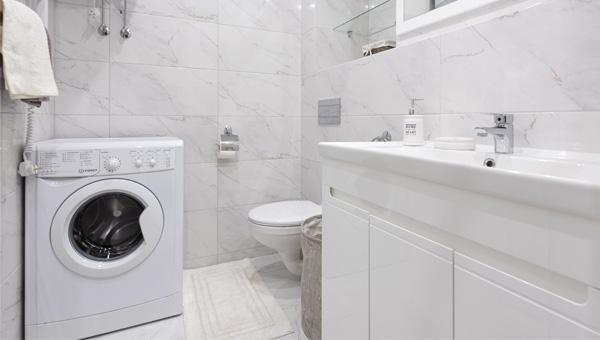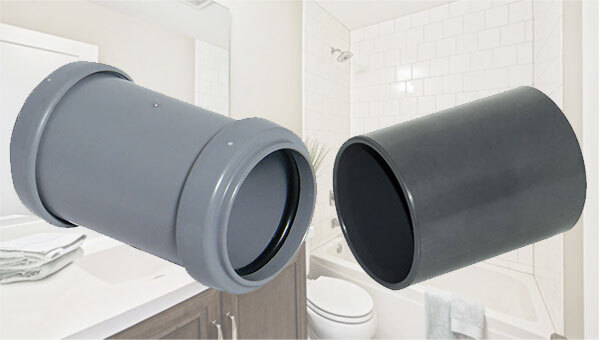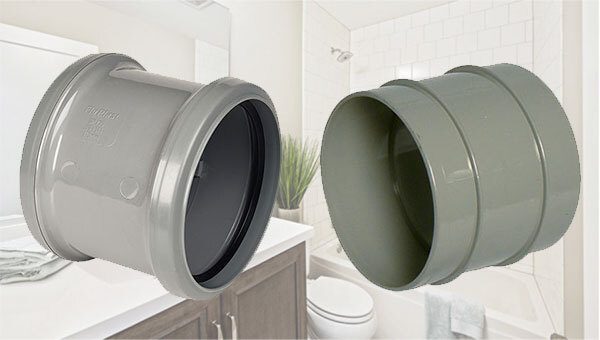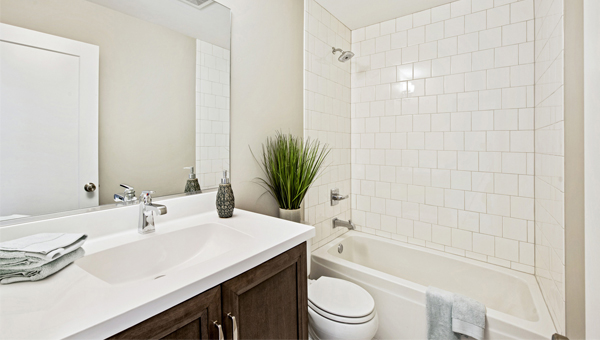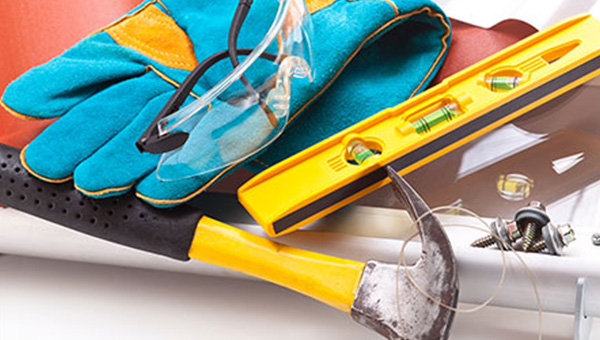
When rainwater gutters are working as they should, most of us will barely even notice they are there. They offer a simple solution that prevents waterfalls running off our roof when it rains and help protect the walls and foundations of our properties from water damage. If they stop working properly, however, you can quickly end up with a big problem on your hands...unless you know how to fix them.
A well maintained guttering system can last a lifetime without ever needing to be replaced. But even the most well looked after gutters can become damaged by the weather or eventually succumb to wear and tear over time. Before you start thinking about replacing your entire guttering system however, there are often simple repair jobs you can do to fix the issues and extend the lifespan of your existing gutters. In this article we will look at some of the most common guttering problems and walk you through how to solve them yourself.
How to fix your gutters
The outside of your house takes a pounding from the elements all year round. It’s the shield that protects you from the wind, the rain, the cold and the heat. However, that shield needs protecting too, and rainwater guttering plays an essential role in that very task. Your gutters and downpipes channel water away from the walls and foundations of your home, where it might otherwise seep in and cause a lot of damage. For this reason, it is imperative that they remain in good working order and that any problems are fixed quickly to keep your house safe.
The best way to do this is with a regular guttering maintenance schedule, but if you already have a problem with your gutters, then we are beyond that point for now. First you need to get your gutters working properly again, then you can think about future maintenance plans. Right now you need to ask yourself one question...
When were your gutters last cleaned?
The very first thing you should do if you discover that your gutters aren’t working properly is to give them a good clean. Guttering systems that have not been regularly maintained for a long time are almost definitely going to have some kind of blockage caused by leaf litter and other debris. Such build-ups can be the root cause of many of the problems listed above. Follow our step-by-step guide for how to clean your gutters if it’s a job you feel confident in tackling yourself.
Giving your gutters and downpipes a good clear out will either fix the problem you had or help you better identify what else needs to be done. Here is a list of the most common guttering issues you might encounter along with tips and advice on how to fix them.
The 10 most common guttering problems
1. Blocked guttering
This is by far and away the most common problem of all when it comes to guttering. While your gutters are perfectly designed to catch water running off your roof, they, unfortunately, also do a great job of catching other things too. Things like leaves, twigs, clumps of moss, and anything else that can be dropped or blown into them, which can all cause blockages if left to build-up for long enough. When this happens, the gutters can no longer drain away the rainwater, causing it to collect behind the blockage until it overflows. This can then also become the root cause of other problems in this list, such as sagging or damaged gutters.
How to fix blocked guttering
The solution to this problem is a very simple one...get up there and clean out whatever is causing the guttering system to clog up. Blockages can occur in the gutters, the downpipe or even the hopper head (if your system has one), and come with varying degrees of difficulty to clear. If you use the guide mentioned above, you should have no problem in getting this problem fixed. Check out the maintenance guide we mentioned earlier too for advice on how to help prevent blockages from occuring in the future.
2. Plants growing in gutters
If you see grass, weeds, or flowers growing out of your gutters, it’s because they’ve not been cleaned in far too long. When certain types of debris in the gutter, such as soil, mix with the rainwater off your roof, it creates a perfect growth environment that’s just waiting for seeds to be dropped or blown into it. This can, of course, contribute to the blockage issue mentioned above, but it also stands as a problem in its own right because of the fact that it can attract wildlife to your gutters as well. Birds, squirrels, mice and rats can all be drawn to the plant matter growing in your gutters, and all of them can cause damage.
How to fix plants growing in gutters
Fortunately, this problem has the same easy fix as the last one...clean your gutters. The more regularly you clean your gutters, the less chance there is for soil and other debris to build-up in them and play host to any wayward seeds.
3. Sagging gutters
Gutters start to sag when the weight inside them becomes too much for their support brackets to hold. This can be caused by blockages, as mentioned above, a buildup of snow in the winter months, or by the improper installation of the system in the first place. Gutter support brackets should be installed no more than 1m apart (closer if you have a particularly steep roof or live in an area prone to heavy snowfall) and no more than 150mm away from any join, bend or stopend. If your gutters do not have adequate support brackets holding them up, then sagging is going to be a real problem for you.
How to fix sagging gutters
Depending on what is causing the gutters to sag, you can do one of three things to fix them:
- Clean out your gutters to remove any debris that could be causing a weight-building blockage or just sitting heavily in there causing unnecessary stress on the joints and supports.
- Install snow/tile guards to protect your guttering from snow sliding off your roof onto them. Snow can be surprisingly heavy when it starts to build-up, and the added weight in your gutters can put a lot of strain on the support brackets, which should be cleared out as soon as possible. However, one of the key culprits in causing gutters to sag (and even collapse) in the winter is the snow that slowly slides off the roof as it melts and hangs on/over the gutters. Installing snow/tile guards at the edge of your roof will hold back the carpet of snow but still allow the meltwater to run into the gutters.
- If there doesn’t appear to be enough support brackets holding up your gutters, adding more with help share the load. Check out our gutter installation guide for instructions on how to do this.
Once you’ve fixed whatever is causing the gutters to sag, double check that none of the existing support brackets have started to pull away from the fascia board/wall. Tighten up any loose ones, relocate any that can't be tightened up, and replace any that are damaged.
4. Incorrect gutter fall
Technically, gutters don’t need to be installed with a fall (slope), but it isn’t hard to see why they should be. If your gutters are installed perfectly level, the only thing pushing the water towards the downpipe is the force of more water running off the roof while it’s raining. When the rain stops, however, some of that water can end up just sitting in the gutter with nowhere to go. Worse yet, during particularly heavy rainfall, your gutters can struggle to drain the water away fast enough to stop it from overflowing. If your gutters constantly overflow, despite there being no sign of any blockages, this could be the cause. Having a gentle fall towards the downpipe helps to prevent these issues and greatly increases the capacity of your gutters. But what can you do if they have already been installed without a fall?
How to fix incorrect gutter fall
When it comes to trying to add a fall to an existing gutter system, you really only have two options:
- Unscrew and re-install each support bracket to gently angle the gutters down towards the downpipe at a gradient of 1:350 - which is roughly a 3mm (0.1inch) drop for every 1 metre (3.3ft). Follow the steps in our gutter installation guide for help in getting the measurements right.
- Depending on the material your gutter brackets are made from, you may be able to slightly bend them to roughly angle the gutters down to the downpipe. This isn’t the best option in our opinion, as you could inadvertently compromise the structural integrity of the support brackets, but it does off a quick-fix solution to see if adding a fall will solve your guttering problems. If it does, we would then recommend replacing the bent brackets and properly installing them with a fall as detailed in our installation guide.
5. Incorrect downpipe positioning
A downpipe (or downspout) should be installed directly above a grid/gully to allow the water from the roof to be channelled away from the buildings foundations and into the surface water drains. If the positioning of the downpipe is off, even slightly, and not all of the water goes into the drain, it can lead to flooding issues during heavy periods of rainfall.
How to fix incorrect downpipe positioning
This will depend on how off centre the downpipe is to the drain point. If it is only slight, then adding a downpipe shoe at the discharge end can help you redirect the flow of water to where it needs to be. If the downpipe is just discharging water onto ground in the hope that it will find its way into the drain, that can be a bigger job to fix. You could try to install an offset bend in the downpipe to redirect it, but this could have a negative impact on the water flow rate of your system. Ultimately, to put it right, you may have to consider removing the entire downpipe and reinstalling it more directly over the drain. Our installation guide offers easy to follow instructions on how to do this too, but if you aren’t certain about where your downpipe should be, it might be worth calling in a professional to take a look for you.
6. Damage to the gutters
Guttering systems can be damaged in a variety of ways, as they are somewhat exposed and vulnerable up at the edge of your roof. Depending on the material they are made from, they can be cracked, dented, snapped and bent out of shape, all of which can lead to other problems such as leaks and blockages. Damage can also be caused by many of these other problems, such as sagging gutters becoming bent out of shape or cracking under the weight caused by a blockage. Whatever the damage is, whether caused by heavy storms overloading the system, or a pair of ladders being lent up against the gutters causing them to snap under the weight, it should always be fixed as soon as possible to prevent further problems being caused.
How to fix damaged gutters
This will depend on the extent of the damage. If, for example, one section of gutter has a crack in it, you may only need to replace that one section, or patch it up at the very least. On the other hand, if heavy snowfall has caused an entire run of guttering to collapse, snapping brackets and bending gutter lengths, you may need to replace and reinforce the whole run. Ultimately, damaged parts should always be replaced if you can afford to do so. A patch job may solve the problem in the short term, but could lead to a bigger, more costly problem in the future.
Most modern guttering systems employ a push-fit design which makes installation and, subsequently, the replacement of individual parts fairly simple and straightforward - especially for plastic guttering systems like the Floplast range we stock here at JDP. As long as you know the size and shape of your guttering (check out our guide to the different types of guttering for help with this), replacing damaged parts should be as easy as popping the damaged piece out and popping the new piece in.
7. Inadequate guttering
If your guttering system is incorrectly sized for the needs of your property, it could be the reason that none of the other fixes have worked for you. No matter how clean or well maintained the system is, if it is not designed to properly cope with the amount of water running off your roof, it is always going to fail. The surface area of your roof, the angle of its slope, and the intensity of rainfall in your area can all greatly affect the size and style of guttering that you need.
How to fix inadequate guttering
Unfortunately, your opinions here are a bit limited. You can try to increase the capacity of your guttering system but making sure there is a sufficient fall to the gutters and/or by adding additional downpipes or moving the existing one to the centre of the gutter run. However, once you have to start thinking about things like that, you may as well just bite the bullet and replace your guttering with a whole new, correctly sized, system. Between our detailed guides to guttering (including how to correctly size your roof, how to plan a new installation, and our step-by-step installation guide) and our extensive range of high-quality Floplast guttering systems (including an attractive “cast-iron effect” range if you are looking for a more rustic aesthetic without the high price tag), we have all you need to replace your guttering yourself and gain the peace of mind that it will properly serve the needs of your property.
8. Water freezing in gutters
During the winter months when temperatures drop below freezing, any water left sitting in your gutters will turn to ice. When water turns to ice, it expands. When ice turns back to water, it contracts. If there is a lot of water in your gutters, this cycle of freezing and thawing can have a terribly damaging effect, distorting the shape of the gutters, forcing joints apart, and even loosening the grip of the push-fit brackets, which can cause the gutters to fall down.
How to fix water freezing in gutters
The only real option you have to thaw frozen gutters is to pour warm water into them to melt the ice. The only problem is that you will just be speeding up the contraction part of the process which can still cause damage to your gutters. Ideally, you want to do your best to prevent the problem from occurring in the first place. Cleaning out your gutters before the winter weather sets in and making sure your gutters are installed with a fall towards the downpipe will reduce the chances of water being able to sit in your gutters. Insulating your loft can also help too, as the warmth in the roof will radiate out and can keep the gutters from freezing. Check out our 10 quick tips to winter proof your home for more advice on preparing for the cold weather.
9. Rusted cast-iron gutters
Rust can be the undoing of metal guttering, especially cast-iron gutters. If left untreated, it will eat holes through the gutters, weaken support brackets, and eventually cause them to fall apart. If you spot rust on your gutters, you need to act fast. Catching it early can save your guttering, but leave it too late and you will end up needing to replace it altogether.
How to fix rusted cast-iron gutters
Remove the rust, prime the guttering and then repaint. That’s the best way to fix this problem. First you need to remove any flaky bits of rust and smooth the affected area - use an emery cloth for small patches and a wire brush for larger ones, being careful not to rub too hard in order to avoid making a hole. Once you have smoothed out all the rust patches, you should coat the guttering with a rust-inhibiting metal primer. This will help protect it from rust in the future. Finally, you’ll need to repaint your guttering with a suitable bitumen or gloss paint to protect the metal from the elements.
If the rust has already started to leave holes in your gutters, they can be fixed with either roof and gutter sealant or glass-fibre filler before repainting. However, if the holes are too big or occur too frequently along your guttering, you really should consider replacing the system.
10. Leaking gutters & downpipes
Last, but by no means least, comes the problems of leaking gutters. This is the problem that can be caused by all others. A problem that can see even the slightest crack or poorly sealed joint turn into a waterfall during a heavy downpour...and you know that it’s nearly always going to be right above your front door. It’s a problem we get asked about so often, in fact, that we’ve decided to give it its very own article to properly look into the causes of leaking gutters and the best ways to fix them.
And that’s it for our top 10 gutter problems and how to fix them. Hopefully we will have covered the problem you’re having and offered a suitable solution to get it sorted. However, if you have a problem we haven’t covered, or need further advice about your rainwater guttering, do not hesitate to contact JDP today. Our technical team is always on hand to help with all of your drainage needs.


